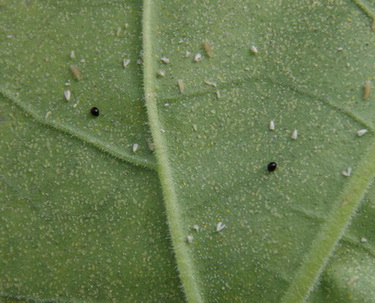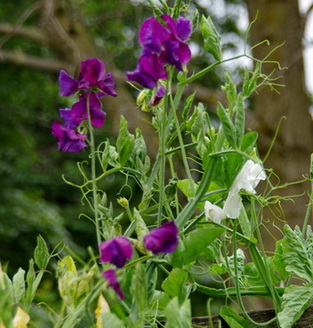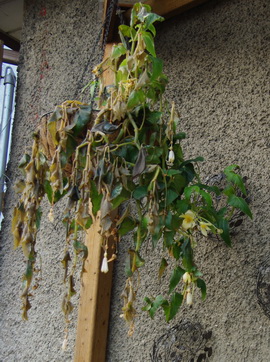| Back to Back Issues Page |
 |
|
Dallying In The Dirt, Issue #190 --- The delphastus are wonderfully hungry. October 03, 2014 |

Now that’s a bit of a weird picture but it’s a closeup of some of the exciting bugs that I saw this week. I spent a few days at a Garden Writer’s meeting in Victoria, B.C. and on one of those days we went touring. We saw no pretty gardens but we certainly saw some interesting stuff and one of the most exciting were those tiny black dots in the picture. Delphastus catalinae are a relative of our common ladybug but about 1/10 the size and as you can see from the pictue they are solid black in colour. Their big feature is their diet. They eat Whitefly, a very common pest of many greenhouse and a few field crops. Those of us who bring our Hibiscus inside for the winter become very familiar with Whitefly by the middle of winter. These guys are voracious and can consume an amazing number of Whitefly. The people at Applied Bionomics have several other good bugs that
they produce to control a variety of plant pests. They do have some trouble finding a way to provide them to home gardeners but they are working on it and some of their distributors do sell some retail quantities. We could have spent much more time their but you can only spend so long in greenhouses filled with clouds of flying Whitefly before you have a sudden urge to go home and shower.  Some years I start Sweet Peas indoors so that they bloom through the summer. This year I was a bit lazy and so the Sweet Peas were direct seeded along with the Sugar Snap Peas. They emerged very slowly. The rabbits ate most of the Sugar Snaps but didn’t touch the Sweet Peas planted with them. The few edibles that survived are long gone but the Sweet Peas have overcome their slow start and are capably demonstrating their love of cool weather. The pea fence is 1.8 M (6ft) tall and you can see that the mass of Sweet Pea blooms are well above that. They will continue to bloom until a very hard frost knocks then down. Until then I will continue to pick small bouquets for the table because Sweet Peas have the most delightful fragrance. Sometimes laziness or procrastination actually has some great rewards.
Some years I start Sweet Peas indoors so that they bloom through the summer. This year I was a bit lazy and so the Sweet Peas were direct seeded along with the Sugar Snap Peas. They emerged very slowly. The rabbits ate most of the Sugar Snaps but didn’t touch the Sweet Peas planted with them. The few edibles that survived are long gone but the Sweet Peas have overcome their slow start and are capably demonstrating their love of cool weather. The pea fence is 1.8 M (6ft) tall and you can see that the mass of Sweet Pea blooms are well above that. They will continue to bloom until a very hard frost knocks then down. Until then I will continue to pick small bouquets for the table because Sweet Peas have the most delightful fragrance. Sometimes laziness or procrastination actually has some great rewards.Now it’s time to answer a few of my reader’s questions. Don’t forget to check the front
page of the Website for frequent short ideas for current gardening activities. Carol Asks? What is this vine? A weed? If so, how does one get rid of it? |
| Back to Back Issues Page |
 Back home the Assistant gardener is busy keeping the new Geranium and Coleus cuttings growing in the propagation bed and watering all the containers. Our extended period of warm weather has kept most of the containers blooming and growing well past their normal finishing time. An interesting thing happened to the
Back home the Assistant gardener is busy keeping the new Geranium and Coleus cuttings growing in the propagation bed and watering all the containers. Our extended period of warm weather has kept most of the containers blooming and growing well past their normal finishing time. An interesting thing happened to the